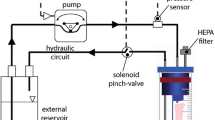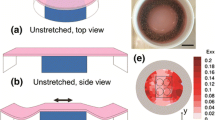Abstract
In this study, we sought to identify the key parameters involved in long-term cyclic distension (CD) as they pertain to the development of collagen-based media-equivalents (MEs). By using only highly compacted, cross-linked constructs, we avoided the complicating issues of irrecoverable creep and transient alignment, and isolated the effects of cyclic mechanical loading on ME development. Our system allowed us to study this development over a wide range of parameters including strain amplitude, pulse frequency, pulse shape, and culture time. We found that in most cases involving cyclic distension, MEs were both stronger and stiffer than constructs that were grown under static conditions. The mechanical properties were not significantly different from static controls after two weeks of CD, however, five weeks of CD was sufficient to note significant increases in both stiffness and strength. The strain, stretch time, and relaxation time were all important variables in determining ME mechanical properties. While we were unable to detect a significant net change in the amount of total collagen, we observed significant deposition of insoluble elastin in our CDMEs, something that has never been previously reported using adult smooth muscle cells. Finally, these changes in ME development did not depend on the age of the MEs prior to the initiation of CD. © 2003 Biomedical Engineering Society.
PAC2003: 8719Rr, 8768+z, 8719Ff, 8780Rb
Similar content being viewed by others
References
Barocas, V. H., T. S. Girton, and R. T. Tranquillo. Engineered alignment in media-equivalents: Magnetic prealignment and mandrel compaction. J. Biomech. Eng.120:660–666, 1998.
Barocas, V. H., A. G. Moon, and R. T. Tranquillo. The fibroblast-populated collagen microsphere assay of cell traction force—Part 2: Measurement of the cell traction parameter. J. Biomech. Eng.117:161–170, 1995.
Barocas, V. H., and R. T. Tranquillo. An anisotropic biphasic theory of tissue-equivalent mechanics: The interplay among cell traction, fibrillar network deformation, fibril alignment, and cell contact guidance. J. Biomech. Eng.119:137–145, 1997.
Birukov, K. G., N. Bardy, S. Lehoux, R. Merval, V. P. Shirinsky, and A. Tedgui. Intraluminal pressure is essential for the maintenance of smooth muscle caldesmon and filamin content in aortic organ culture. Arterioscler., Thromb., Vasc. Biol.18:922–927, 1998.
Birukov, K. G., V. P. Shirinsky, O. V. Stepanova, V. A. Tkachuk, A. W. A. Hahn, T. J. Resnick, and V. N. Smirnov. Stretch affects phenotype and proliferation of vascular smooth muscle cells. Mol. Cell. Biochem.144:131–139, 1995.
Cheng, G. C., W. H. Briggs, D. S. Gerson, P. Libby, A. J. Grodzinsky, M. L. Gray, and R. T. Lee. Mechanical strain tightly controls fibroblast growth factor-2 release from cultured human vascular smooth muscle cells. Circ. Res.80:28–36, 1997.
Chiquet, M., M. Matthisson, M. Koch, M. Tannheimer, and R. Chiquet-Ehrismann. Regulation of extracellular matrix synthesis by mechanical stress. Biochem. Cell Biol.74:737–744, 1996.
Creemers, L. B., I. D. Jansen, A. J. Docherty, J. J. Reynolds, W. Beertsen, and V. Everts. Gelatinase a (mmp-2) and cysteine proteinases are essential for the degradation of collagen in soft connective tissue. Matrix Biol.17:35–46, 1998.
Dartsch, P. C., and H. Hammerle. Orientation response of arterial smooth muscle cells to mechanical stimulation. Eur. J. Cell Biol.41:339–346, 1986.
Dombi, G. W., R. C. Haut, and W. G. Sullivan. Correlation of high-speed tensile strength with collagen content in control and lathyritic rat skin. J. Surg. Res.54:195–229, 1993.
Girton, T. S., V. H. Barocas, and R. T. Tranquillo. Confined compression of a tissue equivalent: Collagen fibril and cell alignment in response to anisotropic strain. J. Biomech. Eng.124:568–575, 2002.
Girton, T. S., E. D. Grassl, B. C. Isenberg, T. R. Oegema, and R. T. Tranquillo. Mechanisms of stiffening and strengthening in media-equivalents fabricated using glycation. J. Biomech. Eng.122:216–223, 2000.
Girton, T. S., T. R. Oegema, and R. T. Tranquillo. Exploiting glycation to stiffen and strengthen tissue equivalents for tissue engineering. J. Biomed. Mater. Res.46:87–92, 1999.
Grassl, E. D., T. R. Oegema, and R. T. Tranquillo. Fibrin as an alternative biopolymer to type-collagen for the fabrication of a media-equivalent. J. Biomed. Mater. Res.60:607–612, 2002.
Grassl, E. D., T. R. Oegema, and R. T. Tranquillo. A fibrin-based arterial media equivalent. (accepted).
Howard, E. W., R. Benton, J. Ahern-Moore, and J. J. Tomasek. Cellular contraction of collagen lattices is inhibited by nonenzymatic glycation. Exp. Cell Res.228:132–145, 1996.
Kanda, K., and T. Matsuda. Behavior of arterial wall cells cultured on periodically stretched substrates. Cell Transplant2:475–484, 1993.
Kanda, K., and T. Matsuda. reconstruction of hybrid arterial media with the molecular and cellular orientations. Cell Transplant3:537–545, 1994.
Kanda, K., T. Matsuda, and T. Oka. Mechanical stress induced cellular orientation and phenotypic modulation of 3–d cultured smooth muscle cells. ASAIO J.39:M686–M690, 1993.
Kerkvliet, E. H., A. J. Docherty, W. Beertsen, and V. Everts. Collagen breakdown in soft connective tissue explants is associated with the level of active gelatinase a (mmp-2) but not with collagenase. Matrix Biol.18:373–380, 1999.
Kim, B.-S., J. Nikolovski, J. Bonadio, and D. J. Mooney. Cyclic mechanical strain regulates the development of engineered smooth muscle tissue. Nature Biotechnol.17:979–983, 1999.
Kolpakov, V., M. D. Rekhter, D. Gordon, W. H. Wang, and T. J. Kulik. Effect of mechanical forces on growth and matrix protein synthesis in the pulmonary artery—Analysis of the role of individual cell types. Circ. Res.77:823–831, 1995.
Kulik, T. J., and S. P. Alvarado. Effect of stretch on growth and collagen synthesis in cultured rat and lamb pulmonary arterial smooth muscle cells. J. Cell Physiol.157:615–624, 1993.
Lee, R. T., C. Yamamoto, Y. Feng, S. Potter-Perigo, W. H. Briggs, K. T. Landschulz, T. G. Turi, J. F. Thompson, P. Libby, and T. N. Wight. Mechanical strain induces specific changes in the synthesis and organization of proteoglycans by vascular smooth muscle cells. J. Biol. Chem.276:13847–13851, 2001.
Li, Q., Y. Muragaki, I. Hatamura, H. Ueno, and A. Ooshima. Stretch-induced collagen synthesis in cultured smooth muscle cells from rabbit aortic media and a possible involvement of angiotensin ii and transforming growth factor-beta. J. Vasc. Res.35:93–103, 1998.
Liu, S. Q.Influence of tensile strain on smooth muscle cell orientation in rat blood vessels. J. Biomech. Eng.120:313–320, 1998.
Mecham, R. P., J. Madaras, J. A. McDonald, and U. Ryan. Elastin production by cultured calf pulmonary artery endothelial cells. J. Cell Physiol.116:282–288, 1983.
Mills, I., C. R. Cohen, K. Kamal, G. Li, T. Shin, W. Du, and B. E. Sumpio. Strain activation of bovine aortic smooth muscle cell proliferation and alignment: Study of strain dependency and the role of protein kinase a and c signaling pathways. J. Cell Physiol.170:228–234, 1997.
Neidert, M. R., E. S. Lee, T. R. Oegema, and R. T. Tranquillo. Enhanced fibrin remodeling for improved tissue-equivalents. Biomaterials23:3717–3731, 2002.
Niklason, L. E., J. Gao, W. M. Abbot, K. K. Hirschi, S. Houser, R. Marini, and R. Langer. Functional arteries grown. Science284:489–493, 1999.
O'Callaghan, C. J., and B. Williams. Mechanical strain-induced extracellular matrix production by human vascular smooth muscle cells: Role of tgf-beta(1). Hypertension36:319–324, 2000.
Owens, G. K.Regulation of differentiation of vascular smooth muscle. Physiol. Rev.75:487–517, 1995.
Owens, G. K.Role of mechanical strain in regulation of differentiation of vascular smooth muscle cells. Circ. Res.79:1054–1055, 1996.
Reusch, P., H. Wagdy, R. Reusch, E. Wilson, and H. E. Ives. Mechanical strain increases smooth muscle and decreases nonmuscle myosin expression in rat vascular smooth muscle cells. Circ. Res.79:1046–1053, 1996.
Seliktar, D., R. A. Black, R. P. Vito, and R. M. Nerem. Dynamic mechanical conditioning of collagen-gel blood vessel constructs induces remodeling. Ann. Biomed. Eng.28:351–362, 2000.
Seliktar, D., R. M. Nerem, and Z. S. Galis. The role of matrix metalloproteinase-2 in the remodeling of cell-seeded vascular constructs subjected to cyclic strain. Ann. Biomed. Eng.29:923–934, 2001.
Smith, P. G., C. Roy, S. Fisher, Q. Q. Huang, and F. Brozovich. Selected contribution: Mechanical strain increases force production and calcium sensitivity in cultured airway smooth muscle cells. J. Appl. Physiol.89:2092–2098, 2000.
Stanley, A. G., H. Patel, A. L. Knight, and B. Williams. Mechanical strain-induced human vascular matrix synthesis: The role of angiotensin ii. J. Renin Angiotensin Aldosterone Syst.1:32–35, 2000.
Stegemann, H., and K. Stalder. Determination of hydroxyproline. Clin. Chim. Acta18:267–273, 1967.
Sudhir, K., K. Hashimura, A. Bobik, R. J. Dilley, G. L. Jennings, and P. J. Little. Mechanical strain stimulates a mitogenic response in coronary vascular smooth muscle cells via release of basic fibroblast growth factor. Am. J. Hypertens.14:1128–1134, 2001.
Sumpio, B. E., and A. J. Banes. Response of porcine aortic smooth muscle cells to cyclic tensional deformation in culture. J. Surg. Res.44:696–701, 1988.
Sumpio, B. E., A. J. Banes, W. Link, and T. Iba. Modulation of endothelial cell phenotype by cyclic stretch: Inhibition of collagen production. J. Surg. Res.48:415–420, 1990.
Sumpio, B. E., A. J. Banes, W. G. Link, and G. Johnson. Enhanced collagen production by smooth muscle cells during repetitive mechanical stretching. Arch. Surg. (Chicago)123:1233–1236, 1988.
Tower, T. T., M. R. Neidert, and R. T. Tranquillo. Fiber alignment imaging during mechanical testing of soft tissues. Ann. Biomed. Eng.30:1–13, 2002.
Tower, T. T.and R. T. Tranquillo. Alignment maps in tissues and fibrillar materials. I. Microscopic elliptical polarimetry. Biophys. J.81:2954–2963, 2001.
Tranquillo, R. T., T. S. Girton, B. A. Bromberek, T. G. Triebes, and D. L. Mooradian. Magnetically orientated tissue-equivalent tubes: Application to a circumferentially orientated media-equivalent. Biomaterials17:349–357, 1996.
Weinberg, C. B., and E. Bell. A blood vessel model constructed from collagen and cultured vascular cells. Science231:397–400, 1986.
Wilson, E., Q. Mai, K. Sudhir, R. H. Weiss, and H. E. Ives. Mechanical strain induces growth of vascular smooth muscle cells via autocrine action of PDGF. J. Cell Biol.123:741–747, 1993.
Woodley, D. T., M. Yamauchi, K. C. Wynn, G. Mechanic, and R. A. Briggaman. Collagen telopeptides (cross-linking sites) play a role in collagen gel lattice contraction. J. Invest. Dermatol.97:580–585, 1991.
Yonter, E. O., T. Scott-Burden, and J. L. West. Increased crosslinking of the extracellular matrix affects mechanical properties of tissue engineered constructs. Sixth World Biomaterials Congress Transactions 392, 2000.
Zeidan, A., I. Nordstrom, K. Dreja, U. Malmqvist, and P. Hellstrand. Stretch-dependent modulation of contractility and growth in smooth muscle of rat portal vein. Circ. Res.87:228–234, 2000.
Author information
Authors and Affiliations
Rights and permissions
About this article
Cite this article
Isenberg, B.C., Tranquillo, R.T. Long-Term Cyclic Distention Enhances the Mechanical Properties of Collagen-Based Media-Equivalents. Annals of Biomedical Engineering 31, 937–949 (2003). https://doi.org/10.1114/1.1590662
Issue Date:
DOI: https://doi.org/10.1114/1.1590662




